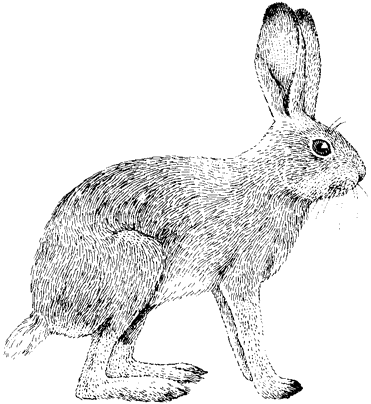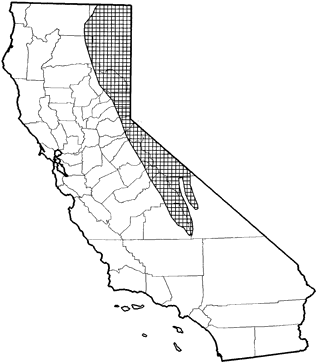
White-tailed Jackrabbit
Distribution, Abundance, and Seasonality
An uncommon to rare year-round resident of the crest and upper eastern slope of the Sierra Nevada, primarily from the Oregon border south to Tulare and Inyo cos. Formerly widespread throughout this range, its population now is fragmented, and numbers apparently have declined drastically. Preferred habitats are sagebrush, subalpine conifer, juniper, alpine dwarf-shrub, and perennial grassland. Also uses low sagebrush, wet meadow, and early successional stages of various conifer habitats. There is seasonal movement from higher to lower elevations in winter (Orr 1937,1940, Ingles 1965, Lim 1987).

Range Map
Specific Habitat Requirements
Feeding: During spring through fall, grasses and a variety of herbaceous plants, including cultivated crops (as encountered), are eaten. In winter, buds, bark, and twigs of shrubs, particularly sagebrush, creambush, and small trees are preferred (Bailey 1931, Orr 1937). Snakeweed and rabbitbrush are favored foods in Utah (Martin et al. 1961). Forages on ground and in lower branches.
Cover: Prefers open areas with scattered shrubs. Orr (1940) found sign most abundant on exposed flat-topped ridges above 2600 m (8500 ft) in El Dorado Co. Like other hares, this species takes cover in a shallow depression (form), usually in shrubby underbrush. Also uses thickets of young conifers or low branches of stunted conifers for cover.
Reproduction: As in other hares (Genus Lepus), young are born in a shallow form or on the ground, usually under brush. Form may be lined with dry leaves, grass or fur.
Water: No data found.
Pattern: Open meadows and flat-topped hills with open stands of trees, some brush, and herbaceous understory are preferred for summer feeding. Young or stunted conifers, or shrubs, are required for day-time cover. Winters are spent in areas with sagebrush, or in thickets of young trees.
Species Life History
Activity Patterns: Activity primarily is nocturnal, sometimes crepuscular.
Seasonal Movements / Migration: In the Sierra Nevada, apparently migrates to higher areas in summer and descends to lower regions in winter, particulary into sagebrush-covered eastern slopes (Orr 1940).
Home Range: Density and home range subject to wide variation. In U.S. and Canada, home range varied from 4-777/ha (10-1920/ac) (Seton 1929). Average density of 8 per km? (21 mi?) found in Colorado (Flinders and Hansen 1973).
Territory: Probably same as home range. Males are highly aggressive during breeding season.
Reproduction: Breeds from February to July. Gestation period lasts 30-42 days, then 1-6 young are born (average 4-5). Commonly produces 3-4 litters per yr in other states, but may not have more than 1 litter in California (Fry 1924). Young forage for themselves soon after birth and are independent at 3-4 wk, or sooner. Sexual maturity in first spring following birth (Whitaker 1980).
Niche: Likely prey for coyotes, bobcats, and larger raptors. The black-tailed hare is a more opportunistic feeder and has been displacing L. townsendii, particularly in areas altered by humans.
Comments: There is little current information regarding population status in California, but evidence polnts to a serious decline. Overgrazing by livestock has been cited as a principal factor (Dalquest 1948), as wel! as cultivation and other development. May now be absent from large portions of its previous range, as in Lasser Co. where the last records are 20 yr old. California Species of Special Concern (Williams 1986). Also called white-tailed jackrabbit.
Sources & References
California Department of Fish and Game, 1999.
California's Wildlife, Sacramento, CA.
Written by: R. Duke, G. Hoefler, reviewed by: H. Shellhammer, edited by: S. Granholm
Bailey, V. 1931. Mammals of New Mexico. U.S. Dep. Agric., North Am. Fauna No. 53. 412pp. Dalquest, W. W. 1948. Mammals of Washington. Univ. Kans. Publ., Mus. Nat. Hist. 2:1-444. Flinders, J. T., and R. M. Hansen. 1973. Abundance and dispersion of leporids within a shortgrass ecosystem. J. Mammal. 54:287-291. Fry, W. 1924. The Sierra white-tailed jackrabbit. Calif. Fish and Game 10:172-175. Ingles, L. G. 1965. Mammals of the Pacific states. Stanford Univ. Press, Stanford, CA. 506pp. Lim, B. K. 1987. Lepus townsendii. Mammal. Species No. 288. 6pp. Martin, A. C., H. S. Zim, and A. L. Nelson. 1961. American wildlife and plants, a guide to wildlife food habits. Dover Publ., Inc., New York. 500pp. Orr, R. T. 1937. Systematics and natural history of Californian hares and rabbits (Family Leporidae). Ph.D. Thesis, Univ. California, Berkeley. 302pp. Orr, R. T. 1940. The rabbits of California. Calif. Acad. Sci. Occas. Pap. No. 19. 227pp. Seton, E. T. 1929. Lives of game animals. 4 vols. Doubleday and Co., Garden City, NY. 3115pp. Whitaker, J. O., Jr. 1980. The Audubon Society field guide to North American mammals. A. Knopf, New York. 745pp. Williams, D. F. 1986. Mammalian species of special concern in California. Calif. Dept. Fish and Game, Sacramento. Admin. Rep. 86-1. 112pp.
California Animal Facts | California's Wildlife